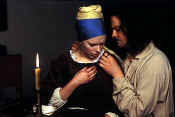By: debbie lynn elias

As many art aficianados know, and as the rest of us less cultured in the masters may recall from art appreciation classes during our formative educational days (unfortunately today’s youth may not be as lucky or informed thanks to lack of funds for the arts in school), one of the preeminent Dutch masters of the 1600’s was Johannes Vermeer. His most reknowned and arguably, most exquisitely enchanting painting is Girl With The Pearl Earring depicting a young woman identifiable only by her pearl earring, with an almost dreamlike thoughtfully yearning look. The painting speaks to the artist, the poet, the academic and the dreamer in us all.
Based on Tracey Chevalier’s best selling novel of the same name, “Pearl Earring” is essentially a love story that transports the reader and the viewer through time courtesy of an intriguing fictional tale of the story behind the painting and the world of Vermeer and Griet, the unknown beautiful young maid who is the painting’s subject. Set in Delft, Holland in 1665, we are taken on a journey into the culture of the day, the minute details of the town itself and Vermeer’s life and the circumstances of the time that would lead a young maiden into a household such as that of Vermeer.
The lovely young Griet is suddenly faced with the prospect of supporting her family following an explosion at a kiln factory which disabled her father who was a tile painter. Griet has no skills and is forced to venture forth into a world of wealth, class difference and religious difference to serve as a maid.
Griet soon finds herself in the employ of Johannes Vermeer. Already somewhat of a legend in the art world, his studio is, for lack of a better term, a pig sty, thanks to his fastidious and even eccentric nature and belief that to touch anything will upset his artistic ventures. Griet fascinates Vermeer. A visually stunning display of Griet placing her vegetables in color spectrum order and sequentially placing them into a cooking pot, is demonstration enough that she is equally as fastidious and idiosyncratic as Vermeer himself, resulting in Vermeer’s complete trust and confidence in her, something that does not sit well with the other staff members. As a result, Griet is invited into his studio to not only clean but enjoy their shared passion for art. His studio becomes their haven
As time goes by, Vermeer and Griet develop a mutual respect and eventual love not only for each other but for art, a fact that does not go unnoticed by Vermeer’s unbalanced wife, certain of his children or his mother-in-law, Maria. (Obviously this is a trend that has existed since the beginning of time.) Always the mercenary, rather than discourage the relationship between Vermeer and Griet, Maria encourages the friendship and also plays matchmaker for Griet and Vermeer’s wealthiest client, van Ruijven. It’s not long before a painting of Griet is commissioned and we see first-hand why business and pleasure should never mix.
Scarlett Johanson is breathtakingly exquisite as the young Griet and thanks to cinematographer Eduardo Serra, looks incredibly like the unknown woman in the Vermeer painting, capturing the very essence of the subject to such a degree that one must wonder, is this a fantasy or is it real. Her subtlety at projecting emotion only captivates the viewer more.
Colin Firth simply smolders as Johannes Vermeer. (Let’s face it. He can pretty much smolder in anything.) He has a talent for blending whimsy with mystery and a tacit effusiveness for things passionate to his heart. Here, he makes the very essence of Vermeer come to life and never moreso than in one-on-ones with the Griet character as they discuss light, shadows, color and texture with subtle inflections that hint at art mirroring the fabric of life.
The generally engaging Tom Wilkinson is disappointing here as van Ruijven. Although lecherously swarmy as befits the character, the performance seems an ill fit for Wilkinson, thus detracting from any otherwise superlative work.
This is cinematic art at its finest. First time director Peter Webber succeeded in capturing the same beauty and inspiration of the painting thanks to his great attention to detail, a broad canvas look not pigeonholed into a paint-by-numbers format with integrity and faithfulness to Chevalier’s already fanciful yarn. With the finesse and delicacy of the very stroke of Vermeer, cinematographer Eduardo Serra then provides a visually stunning masterpiece worthy of the artistic work of Vermeer himself, giving layers and textures to the celluloid visuals as if Vermeer’s brush were guiding every shot. Look for Serra to be front and center when Oscar nominations are announced.
“Girl With The Pearl Earring” – a visually stunning masterpiece with the beauty and elegance of a single perfect pearl.
Colin Firth: Johannes Vermeer Scarlett Johansson: Griet Tom Wilkinson: van Ruijven Judy Parfitt: Maria Thins
Directed by Peter Webber. Written by Olivia Hetreed based on a novel by Tracey Chevalier. Distributed by Lions Gate Films. Rated PG-13. (99 min.)












